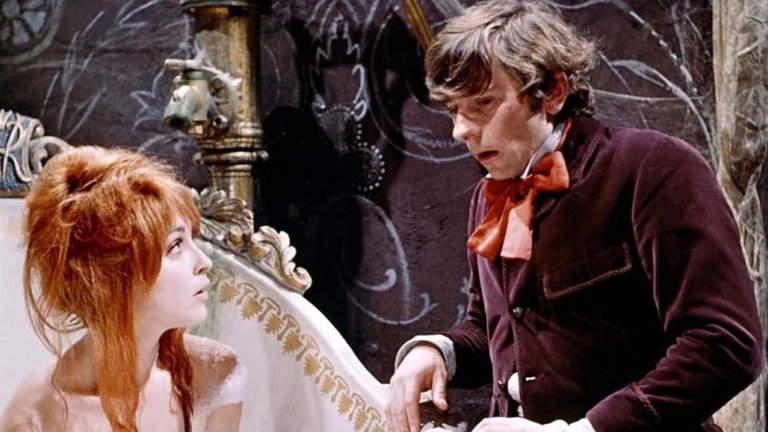Film Review: The Fearless Vampire Killers (1967)

If a single word could encapsulate Roman Polanski’s filmography, it would undeniably be “dark.” From the psychological torment of Repulsion (1965) to the nihilistic brutality of Macbeth (1971), his works are steeped in existential dread and moral ambiguity. Yet one of the great ironies of this shadow-laden oeuvre is that the film often regarded as his most macabre—The Fearless Vampire Killers (1967)—is, at its core, a comedy. Beneath its farcical veneer lies a grotesque tableau of vampiric decadence, rendering it a paradoxically chilling entry in Polanski’s catalogue, even as it lampoons the Gothic horror tropes it ostensibly venerates.
Set in a snowbound Transylvanian village during the 19th century, the film follows Professor Abronsius (played by Jack MacGowran), a pompous academic obsessed with eradicating vampirism, and his hapless apprentice Alfred (played by Polanski himself). Arriving at an inn run by the superstitious Yoyneh Shagal (played by Alfie Bass), the duo quickly discern the locals’ peculiar rituals—garlic-strewn windows, fervent prayers—to repel unseen evils. Alfred becomes smitten with Shagal’s coquettish daughter, Sarah (played by Sharon Tate), whose abduction by the aristocratic Count von Krolock (played by Ferdy Mayne) sets the plot in motion. A desperate Shagal transforms into a vampire after unsuccessful attempt to rescue her, inadvertently guiding Abronsius and Alfred to von Krolock’s fortress-like castle. There, they encounter the Count’s flamboyantly effete son Herbert (played by Iain Quarrier), whose predatory advances toward Alfred inject a risqué subtext. The narrative crescendos with the pair’s bumbling attempts to thwart von Krolock’s grand “ball,” a bacchanal of the undead poised to unleash eternal night.
Polanski’s film operates foremost as a spoof of the Gothic horror canon, particularly the technicolor melodramas churned out by Britain’s Hammer Films in the 1960s. The screenplay, co-written with Gerald Brach, gleefully skewers genre clichés—creaking coffins, fang-baring aristocrats—while infusing them with a distinctly Eastern European sensibility. From the villagers’ thick Yiddish-inflected accents to the stark, folkloric landscapes (partly shot in the Italian Dolomites), Polanski grounds the absurdity in a cultural authenticity absent from Hammer’s stagey productions. Describing the film as a “fairy tale for adults,” he marries childlike whimsy with sly innuendo, epitomised by Alfred’s pratfalls and von Krolock’s theatrical menace.
Produced largely in British studios, the film juxtaposes lowbrow slapstick—Abronsius comically frozen mid-snoop, Alfred skidding across icy floors—with exploitative titillation. Sharon Tate’s Sarah, often depicted luxuriating in a brass tub, serves as both ingénue and object of voyeurism, her frequent disrobing emblematic of the era’s loosening censorship. This permissiveness extends to Herbert’s overtly queer persona, a rarity for 1960s cinema. His mincing demeanour and predatory pursuit of Alfred frame vampirism as a metaphor for repressed homosexuality, a theme later exploited (quite literally) in the 1970s lesbian vampire wave (The Vampire Lovers, Daughters of Darkness). While Herbert’s caricature risks dated offensiveness, it undeniably reflects the countercultural shifts of the late 1960s.
The film’s tonal balance between horror and humour is admirably sustained, though occasionally undermined by excessive camp. MacGowran’s Abronsius, all bug-eyed exasperation and flailing limbs, veers into pantomime, while Polanski’s wide-eyed Alfred channels Buster Keaton via vaudeville. Such broad performances, though intentional, occasionally dilute the eerie atmosphere—a snowlit chase through crypts, say, undercut by a clumsily timed gag.
Less successful is Krzysztof Komeda’s jazz-inflected score. While the composer’s prior collaborations with Polanski (Rosemary’s Baby) yielded haunting minimalism, here the brassy, swing-inspired motifs clash jarringly with the Gothic setting. A harpsichord-heavy arrangement might have better complemented the period farce; instead, the anachronistic soundtrack lends the film a self-consciously “arty” sheen at odds with its slapstick heart.
Upon release, The Fearless Vampire Killers garnered modest acclaim, its zany premise and visual wit resonating with audiences. Yet its legacy became irrevocably haunted by tragedy. Polanski, much like his character Alfred, fell deeply for Tate during filming; their subsequent marriage ended horrifically in 1969 when she, eight months pregnant, was murdered by the Manson Family. The parallels between Sarah’s fictional abduction and Tate’s real-life slaughter cast a morbid pall over the film, transforming it from lighthearted romp to unwitting premonition.
In retrospect, The Fearless Vampire Killers remains a fascinating curio—a film where Polanski’s penchant for the grotesque collides with his underappreciated knack for satire. While uneven in execution, its melding of Hammer parody and folkloric dread showcases a director playfully deconstructing genre even as personal and historical darkness loomed on the horizon.
RATING: 7/10 (+++)
Posted Using INLEO